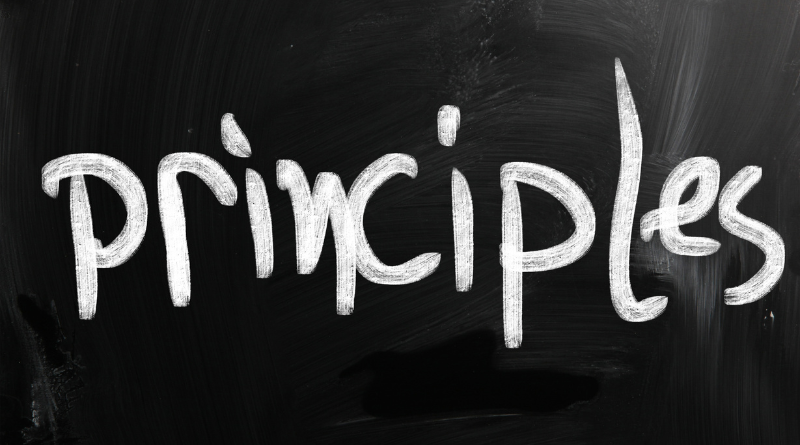
DC generators, also called dynamos, convert mechanical energy into direct current. These machines have been instrumental in generating electricity for many years. In this article, we will examine the working principle and design of DC generators and examine the basic concepts and components that enable their effective operation.
Direct current generator principle
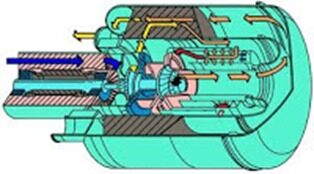
An electrical generator is a machine that converts mechanical energy into electrical energy. Energy conversion is based on the principle of forming a dynamically induced electromotive force. As can be seen in Figure 1, a dynamically induced electromotive force arises in a conductor that interrupts the magnetic flow, which corresponds to Faraday's laws of magnetic force induction. This electromotive force causes current to flow when the conducting circuit is closed.
Therefore, the two essential basic elements of an electrical generator are a field and one or more conductors that can move and interrupt the flow.
Construction of a direct current generator
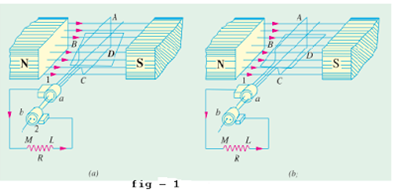
The illustration above shows a single-turn rectangular copper coil ABCD rotating about its axis in a magnetic field created by a magnetron or electromagnets. The two ends of the coil are connected to two slip rings, “a” and “b”, which are isolated from each other and from the central axis. Two collector brushes (made of carbon or copper) press on the collector rings. Its function is to collect the energy generated in the coil and direct it to the external load resistor R. The rotating coil is also called the “armature” and the magnets are called “field magnets”.
How a DC Generator Works
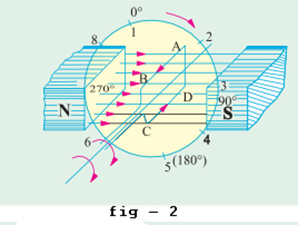
Imagine the coil rotating clockwise, as shown in Figure 2. As the coil assumes successive positions within the field, it changes the flux associated with it. Therefore, an electromotive force is induced in it, which is proportional to the speed of change in the flow connections (e = NdΦ dt).
Since the plane of the coil is perpendicular to the flux lines, that is, once in position 1, the flux associated with the coil is stronger; however, the rate of change of river connections is minimal.
This occurs because in this position the AB and CD sides of the coil do not intercept or cut off the flow. Instead, they slide over them, that is, they move parallel to them. Therefore, no electromotive force is induced in the coil. We take this electromotive zero or vertical position of the coil as the initial position. Rotation angles or time are measured from this position. As the coil continues to rotate, the rate of change in the flux links increases until position three is reached, where θ = 90º. Here the plane of the coil is horizontal, i.e., parallel to the lines of flux. As you can see, the flux associated with the coil is the lowest. However, the rate of change of flow links is the highest. Therefore, in this position, the maximum electromotive force is induced once in the coil, as shown in Figure 3.
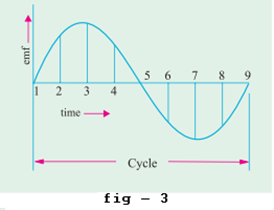
In the next quarter turn, that is, from 90º to 180º, the flux associated with the winding will gradually increase. However, the rate of change in river connections is slowing. Therefore, the induced electromotive force gradually decreases until it is reduced to zero at position five of the coil.
Direction of induced current
Thus, we find that within half a revolution of the coil, no electromotive force is induced once at position 1, once at position 3, and once at position 5. The directions of this induced electromotive force are often determined by applying the right-hand rule of Fleming, which gives the direction from A to B and from C to D. Therefore, the direction of current flow is ABMLCD. Current through the load resistor R flows from M to L during the entire first revolution of the coil.
Reversal of current direction
In the next revolution, that is, from 180º to 360º, the variations in the magnitude of the square of the electromotive force are almost as great as in the middle of the revolution. Its rate is highest when the coil is in position 7 and lowest when it is in position 1. However, it can be observed that the direction of the induced current is from D to C and from B to A, as shown in Figure 1. Therefore, the current flow direction is in DCLMBA, which is simply the reverse of the previous flow direction. Therefore, we discover that the current we obtain from such a simple generator reverses its direction with each revolution. Such a current that undergoes periodic reversals is considered an alternating current. It is obviously different from a direct current, which flows indefinitely in one and therefore in the same direction. It should be noted that electrical energy does not just reverse direction; does not maintain its constant size when flowing in any direction. The two half cycles are also called positive and negative half cycles.
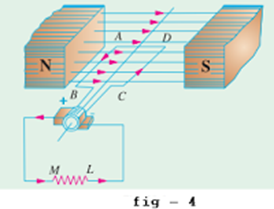
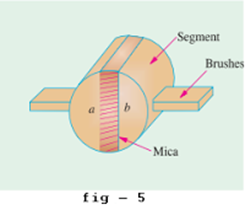
Use of split rings
To simplify the current flow in the external circuit, the slip rings are replaced with wear rings, as shown in Figure 4 above. Split rings consist of a conducting cylinder divided into two halves or segments, which are insulated from each other by a thin layer of translucent material or other insulating material, as shown in Figure 5.
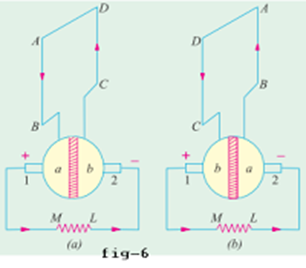
Reversing current direction with split rings
As before, the ends of the coil are connected perpendicular to the segments on which the carbon or copper brushes rest. In Fig 6, we saw that during the half revolution the current flows (ABMNLCD), that is, the carrier phase of brush #1 “a” acts as the positive end of availability and “b” as the negative end. The direction of the current induced in the coil was reversed during the next revolution. However, with constant time, the positions of segments “a” and “b” were also inverted, causing brush #1 to enter the positive phase, that is, phase “b” in this case. Therefore, the current in the load resistor again flows from M to L. The wave of current through the external circuit is shown in Fig. This current is simple but not continuous like pure electricity.
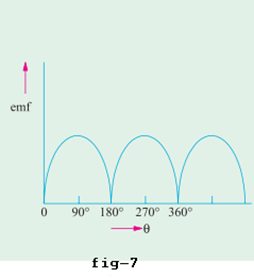
Split ring rectifier effect
It should be noted that the position of the brushes is organized in such a way that the change of segments “a” and “b” from one brush to another occurs as soon as the plane of the rotating coil is perpendicular to the plane of the flux lines. This occurs because in this position the electromotive force induced in the coil is zero.
Induced voltage and alternating current
Another important purpose of price memory is to ensure that the current induced on the sides of the coil alternates smoothly. Only through the rectification effect of the split rings (commutator) does it become simplex in the external circuit. Therefore, it should be clear that the induced voltage varies even in the coil of a DC generator.

